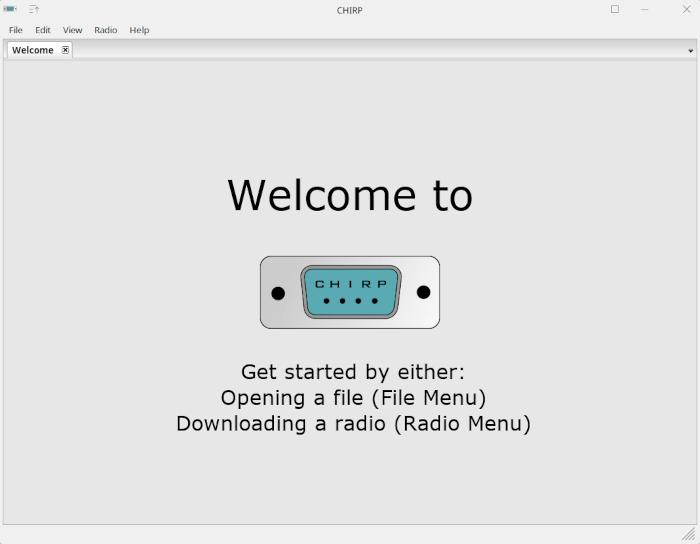CHIRP is a tool for programming your radio. It supports a large number of manufacturers and models, as well as provides a way to interface with multiple data sources and formats.
This is free and open source software. It’s cross-platform running under Linux, macOS, and Windows.
Step 1: Download contents from the radio
- Start CHIRP and Click the Radio menu and choose Download From Radio.
- The Clone window opens.
- Select the serial port you intend to use from the drop down menu.
- Select the correct Vendor and (if necessary) the appropriate Model.
- Click OK to start the download process. Clone-mode radios will display a progress bar indicating how much of the image has been downloaded. Live-mode radios will immediately jump to the memory editor and begin to populate it with memories as they are downloaded from the radio.
Note for Yaesu radios: There are series of steps that must be followed in order for most Yaesu radios to be properly cloned. The above process is still accurate, but keep in mind the following:
The radio should already be in clone mode before clicking the OK button to initiate the download (step 5 above).
After clicking the OK button (step 5 above), you should press the button on your radio that initiates the clone transmission. This is usually indicated on the screen by Clone TX or similar.
Step 2: Make changes
Once you have the radio contents displayed in the memory editor, you can proceed to make your changes. This may include manual edits or importing memories from other sources. If you are using a clone-mode radio, you may wish to save a .img file of your radio as and after you make your changes. Live mode radio users will have their changes immediately take effect in the radio and do not need to proceed to Step 3.
Step 3: Upload changes back to the radio
(For clone-mode radios only!)
Once you have made all the edits you need to make, you should upload your image back to the radio. With your image open, go to the Radio menu and choose Upload To Radio. The Vendor and Model are already known, so all you need to do is choose a serial port.
Note for Yaesu radios: Like the download procedure, the upload procedure must follow a particular sequence. Make sure that your radio is already in clone mode and it is already waiting for an incoming clone transmission. This is usually indicated on the screen by Clone Wait or Clone RX.
Website: chirpmyradio.com/projects/chirp/wiki/Home
Support:
Developer: CHIRP
License: GNU General Public License v3.0

CHIRP is written in Python. Learn Python with our recommended free books and free tutorials.
| Popular series | |
|---|---|
| The largest compilation of the best free and open source software in the universe. Each article is supplied with a legendary ratings chart helping you to make informed decisions. | |
| Hundreds of in-depth reviews offering our unbiased and expert opinion on software. We offer helpful and impartial information. | |
| The Big List of Active Linux Distros is a large compilation of actively developed Linux distributions. | |
| Replace proprietary software with open source alternatives: Google, Microsoft, Apple, Adobe, IBM, Autodesk, Oracle, Atlassian, Corel, Cisco, Intuit, SAS, Progress, Salesforce, and Citrix | |
| Awesome Free Linux Games Tools showcases a series of tools that making gaming on Linux a more pleasurable experience. This is a new series. | |
| Machine Learning explores practical applications of machine learning and deep learning from a Linux perspective. We've written reviews of more than 40 self-hosted apps. All are free and open source. | |
| New to Linux? Read our Linux for Starters series. We start right at the basics and teach you everything you need to know to get started with Linux. | |
| Alternatives to popular CLI tools showcases essential tools that are modern replacements for core Linux utilities. | |
| Essential Linux system tools focuses on small, indispensable utilities, useful for system administrators as well as regular users. | |
| Linux utilities to maximise your productivity. Small, indispensable tools, useful for anyone running a Linux machine. | |
| Surveys popular streaming services from a Linux perspective: Amazon Music Unlimited, Myuzi, Spotify, Deezer, Tidal. | |
| Saving Money with Linux looks at how you can reduce your energy bills running Linux. | |
| Home computers became commonplace in the 1980s. Emulate home computers including the Commodore 64, Amiga, Atari ST, ZX81, Amstrad CPC, and ZX Spectrum. | |
| Now and Then examines how promising open source software fared over the years. It can be a bumpy ride. | |
| Linux at Home looks at a range of home activities where Linux can play its part, making the most of our time at home, keeping active and engaged. | |
| Linux Candy reveals the lighter side of Linux. Have some fun and escape from the daily drudgery. | |
| Getting Started with Docker helps you master Docker, a set of platform as a service products that delivers software in packages called containers. | |
| Best Free Android Apps. We showcase free Android apps that are definitely worth downloading. There's a strict eligibility criteria for inclusion in this series. | |
| These best free books accelerate your learning of every programming language. Learn a new language today! | |
| These free tutorials offer the perfect tonic to our free programming books series. | |
| Linux Around The World showcases usergroups that are relevant to Linux enthusiasts. Great ways to meet up with fellow enthusiasts. | |
| Stars and Stripes is an occasional series looking at the impact of Linux in the USA. | |
